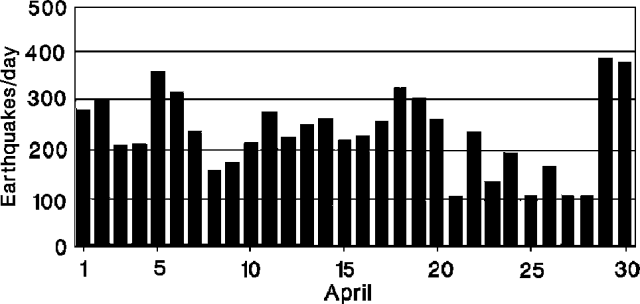Report on Poas (Costa Rica) — April 1991
Bulletin of the Global Volcanism Network, vol. 16, no. 4 (April 1991)
Managing Editor: Lindsay McClelland.
Poas (Costa Rica) Increased gas emission; continued seismicity
Please cite this report as:
Global Volcanism Program, 1991. Report on Poas (Costa Rica) (McClelland, L., ed.). Bulletin of the Global Volcanism Network, 16:4. Smithsonian Institution. https://doi.org/10.5479/si.GVP.BGVN199104-345040
Poas
Costa Rica
10.2°N, 84.233°W; summit elev. 2697 m
All times are local (unless otherwise noted)
Gas emission increased in April. Fumaroles burned sulfur, produced loud jet-engine noises, and ejected small amounts of gray sediment that covered the W base of the crater. Acid rain continued to be a problem on the W flank of the volcano; rainwater pH was 3.4 at Cerro Pelón (2.5 km SW).
Seismicity levels in April were similar to March, with an average of 266 low-frequency earthquakes recorded/day (average frequency 2.2 Hz) and a monthly total of 26 high-frequency events (figure 37). Low-frequency tremor was recorded up to 22 hours/day on 20-21 April.
Geological Summary. The broad vegetated edifice of Poás, one of the most active volcanoes of Costa Rica, contains three craters along a N-S line. The frequently visited multi-hued summit crater lakes of the basaltic-to-dacitic volcano are easily accessible by vehicle from the nearby capital city of San José. A N-S-trending fissure cutting the complex stratovolcano extends to the lower N flank, where it has produced the Congo stratovolcano and several lake-filled maars. The southernmost of the two summit crater lakes, Botos, last erupted about 7,500 years ago. The more prominent geothermally heated northern lake, Laguna Caliente, is one of the world's most acidic natural lakes, with a pH of near zero. It has been the site of frequent phreatic and phreatomagmatic eruptions since an eruption was reported in 1828. Eruptions often include geyser-like ejections of crater-lake water.
Information Contacts: E. Fernández, V. Barboza, and J. Barquero, OVSICORI.


